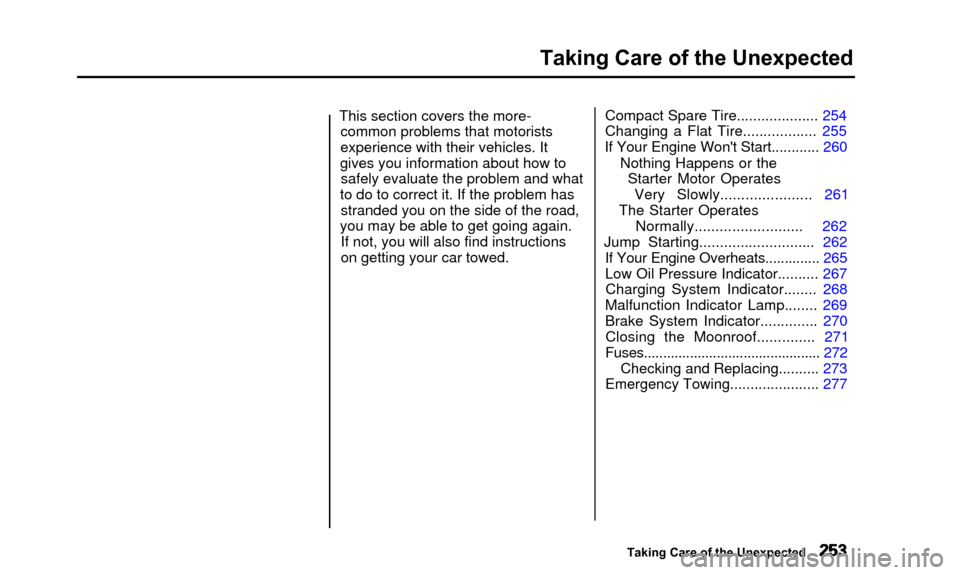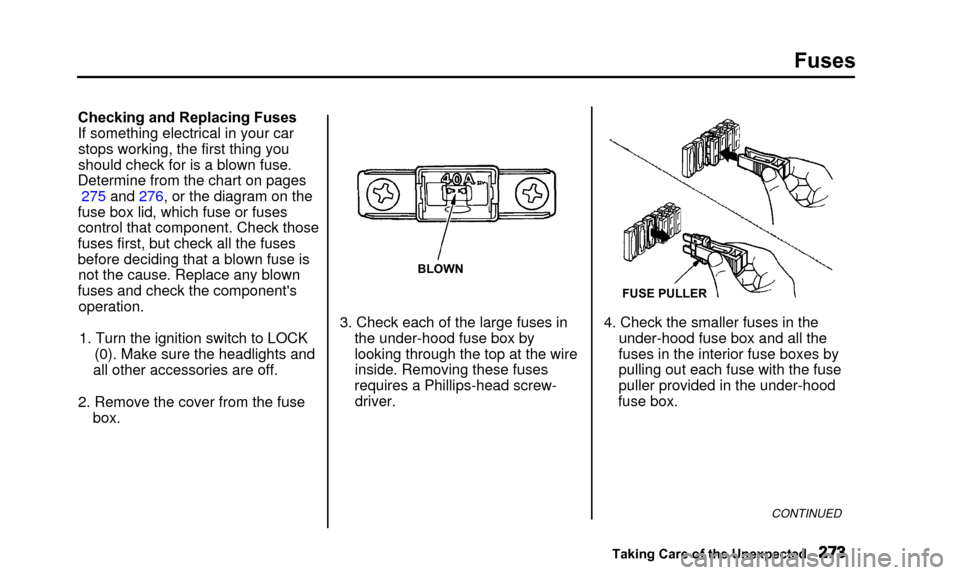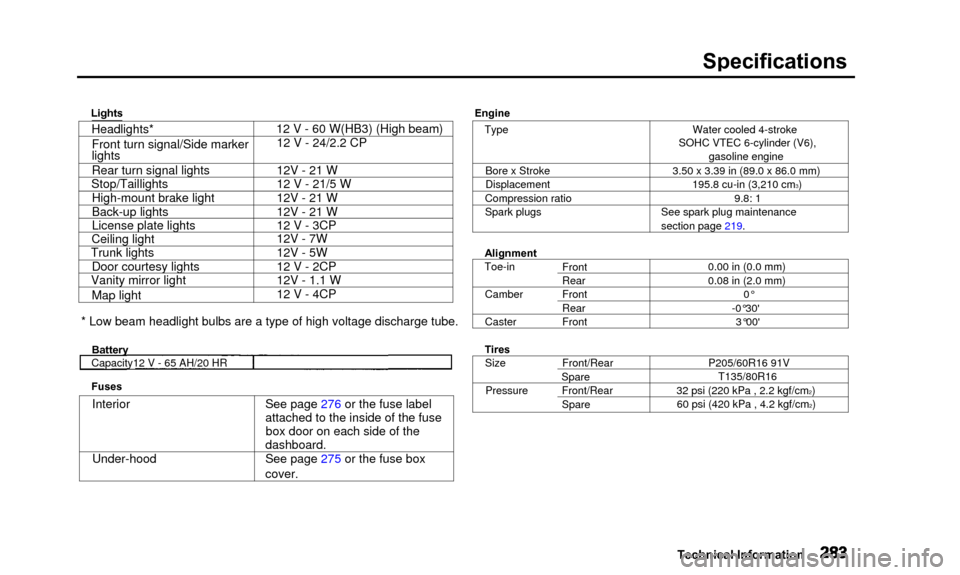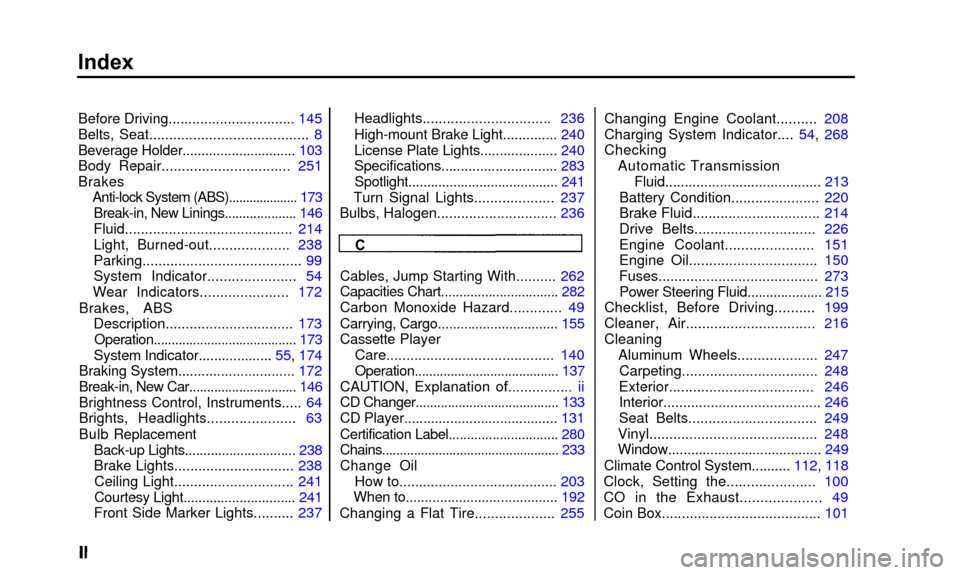fuses Acura TL 2000 3.2 Owner's Manual
[x] Cancel search | Manufacturer: ACURA, Model Year: 2000, Model line: TL, Model: Acura TL 2000Pages: 311, PDF Size: 3.05 MB
Page 256 of 311

Taking Care of the Unexpected
This section covers the more-common problems that motorists
experience with their vehicles. It
gives you information about how to safely evaluate the problem and what
to do to correct it. If the problem has stranded you on the side of the road,
you may be able to get going again. If not, you will also find instructions
on getting your car towed. Compact Spare Tire.................... 254
Changing a Flat Tire.................. 255
If Your Engine Won't Start............ 260
Nothing Happens or theStarter Motor OperatesVery Slowly...................... 261
The Starter Operates
Normally.......................... 262
Jump Starting............................ 262
If Your Engine Overheats.............. 265
Low Oil Pressure Indicator.......... 267 Charging System Indicator........ 268
Malfunction Indicator Lamp ........ 269
Brake System Indicator .............. 270
Closing the Moonroof.............. 271
Fuses.............................................. 272
Checking and Replacing.......... 273
Emergency Towing ...................... 277
Taking Care of the Unexpected
Page 264 of 311

If Your Engine Won't Start
Nothing Happens or the Starter
Motor Operates Very Slowly
When you turn the ignition switch to START (III), you do not hear the
normal noise of the engine trying tostart. You may hear a clicking sound
or series of clicks, or nothing at all.
Check these things:• Check the transmission interlock. The transmission must be in Parkor Neutral or the starter will not
operate.
• Turn the ignition switch to ON (II).
Turn on the headlights and check their brightness. If the headlightsare very dim or don't light at all,
the battery is discharged. See
Jump Starting on page 262.
• Turn the ignition switch to START (III). If the headlights do not dim,
check the condition of the fuses. If
the fuses are OK, there is proba-
bly something wrong with the electrical circuit for the ignitionswitch or starter motor. You will
need a qualified technician to determine the problem. (See
Emergency Towing on page 277.)
If the headlights dim noticeably or
go out when you try to start the engine, either the battery is dis-
charged or the connections are
corroded. Check the condition of
the battery and terminal connec- tions (see page 220). You can
then try jump starting the car froma booster battery (see page 262).
Taking Care of the Unexpected
Page 265 of 311

If Your Engine Won't Start, Jump Starting
The Starter Operates NormallyIn this case, the starter motor's
speed sounds normal, or even faster
than normal, when you turn the
ignition switch to START (III), but
the engine does not run.
• Your car has the Immobilizer System. You should use a
properly-coded master or valet key
to start the engine (see page 74).
A key that is not properly coded will cause the immobilizer systemindicator in the dash panel to blink
rapidly.
• Are you using the proper starting procedure? Refer to Starting theEngine on page 161.
• Do you have fuel? Turn the
ignition switch to ON (II) for a
minute and watch the fuel gauge.
The low fuel level warning light may not be working, so you were
not reminded to fill the tank.
• There may be an electrical problem, such as no power to the
fuel pump. Check all the fuses (see page 273).
If you find nothing wrong, you will
need a qualified technician to find
the problem. See Emergency
Towing on page 277. Jump Starting
If your car's battery has run down,
you may be able to start the engine by using a booster battery. Although
this seems like a simple procedure,
you should take several precautions.
A battery can explode if you donot follow the correct procedure,
seriously injuring anyone nearby.
Keep all sparks, open flames,
and smoking materials away
from the battery.
You cannot start your Acura by pushing or pulling it.
Taking Care of the Unexpected
Page 275 of 311

Fuses
All the electrical circuits in your carhave fuses to protect them from a short circuit or overload. These
fuses are located in three fuse boxes.INTERIOR
The interior fuse boxes are located on each side of the dashboard. To
open an interior fuse box, open the
car door. Pull the bottom of the
cover open, then take it out of itsside hinges by pulling it toward you.
UNDER-HOOD
The under-hood fuse box is located in the back of the engine compart-
ment on the passenger's side. To
open it, push the tabs as shown.
Taking Care of the Unexpected
TAB
Page 276 of 311

Fuses
Checking and Replacing Fuses
If something electrical in your car stops working, the first thing you
should check for is a blown fuse.
Determine from the chart on pages 275 and 276, or the diagram on the
fuse box lid, which fuse or fuses control that component. Check those
fuses first, but check all the fuses
before deciding that a blown fuse is not the cause. Replace any blown
fuses and check the component's operation.
1. Turn the ignition switch to LOCK (0). Make sure the headlights and
all other accessories are off.
2. Remove the cover from the fuse box.
BLOWN
3. Check each of the large fuses inthe under-hood fuse box by
looking through the top at the wireinside. Removing these fuses
requires a Phillips-head screw- driver.
FUSE PULLER
4. Check the smaller fuses in the under-hood fuse box and all the
fuses in the interior fuse boxes by
pulling out each fuse with the fuse
puller provided in the under-hood
fuse box.
CONTINUED
Taking Care of the Unexpected
Page 277 of 311

Fuses
BLOWN
5. Look for a burned wire inside thefuse. If it is burned, replace it withone of the spare fuses of the same
rating or lower. If you cannot drive the car without
fixing the problem, and you do not
have a spare fuse, take a fuse of the same rating or a lower rating from
one of the other circuits. Make sure
you can do without that circuit temporarily (such as the accessorypower socket or radio).
If you replace the blown fuse with aspare fuse that has a lower rating, it
might blow out again. This does not indicate anything wrong. Replace the
fuse with one of the correct rating as soon as you can.
Replacing a fuse with one that has a
higher rating greatly increases the
chances of damaging the electrical
system. If you do not have a replace-
ment fuse with the proper rating for the
circuit, install one with a lower rating.
6. If the replacement fuse of the same rating blows in a short time,
there is probably a serious
electrical problem in your car. Leave the blown fuse in that
circuit and have your car checked
by a qualified mechanic.
If the radio fuse is removed, the
audio system will disable itself. The next time you turn on the radio you
will see "Code" in the frequency display. Use the Preset buttons to
enter the five-digit code (see page 142).
Taking Care of the Unexpected
NOTICE
Page 278 of 311

Fuses
UNDER-HOOD FUSE BOXNo.1
2
3
4 5
6
7
8
9
10 11 Amps.
20 A-
20 A
20 A 20 A15 A -
30 A 15 A
120 A 20 A Circuits Protected
Left Headlight
Not Used
Right Headlight
ABS F/S Stop
ACG
Spare Fuse
ABS Motor
Hazard
BatteryCooling FanNo.
1213
14
15
16
17
18 19
20
21 Amps.
30 A
40 A-
40 A
20 A
40 A
40A
50 A 15 A
20 A Circuits Protected
Back Up, ACC Power Window Motor
Spare Fuse
Power Seat
TCS Heater Motor
Rear Defroster
IG1 Main
Small Light
Condenser Fan
CONTINUED
Taking Care of the Unexpected
Page 279 of 311

Fuses
INTERIOR FUSE BOXES
DRIVER'S SIDE
No.1
2
3
4 5
6
7
8 9
10
11 12
13 Amps.
15 A
10 A
7.5 A
7.5 A
7.5 A
15 A
7.5 A
7.5 A 7.5 A
7.5 A 15 A
30 A
7.5 A Circuits Protected
Fuel Pump
SRS
Heater Control
Mirror
Daytime Running Lights*
ECU (ECM/PCM), Cruise Control
SRS
ACC Instrument Panel, Back-up
Lights, Moonroof
IG1 Turn Signals
IG1 Coil
Wiper, Washer Starter Signal PASSENGER'S SIDE
* : On Canadian models
No.
1
2
3
4
5
6 7
8
9
10
11
12
13
14
15
16 Amps.
30 A
20 A
20 A
20 A
20 A
20 A 20 A
20 A
20 A 10 A
7.5 A 20 A
7.5 A
7.5 A 20 A
20 A Circuits Protected
Moonroof
Power Seat Recline
Heated Seat
Driver's Power Seat
Assistant Power Seat Seat Recline
Rear Left Power Window
Front Right Power Window
ACC (Radio) Navigation System, Daytime
Running Lights*
Interior Light, Courtesy
Lights
Power Door Locks
Clock
ABS Motor Check
Driver's Power Window
Rear Right Power Window
* : On Canadian models
Taking Care of the Unexpected
Page 286 of 311

Specifications
Lights
TypeBore x Stroke
Displacement
Compression ratio
Spark plugs
Alignment
Toe-in Camber
Caster
Tires Size
Pressure Front
Rear
Front
Rear
Front
Front/Rear
Spare Front/Rear
Spare Water cooled 4-stroke
SOHC VTEC 6-cylinder (V6), gasoline engine
3.50 x 3.39 in (89.0 x 86.0 mm) 195.8 cu-in (3,210 cm
3)
9.8: 1
See spark plug maintenance
section page 219.
0.00 in (0.0 mm)
0.08 in (2.0 mm)0°
-0°30' 3°00'
P205/60R16 91V T135/80R16
32 psi (220 kPa , 2.2 kgf/cm
2)
60 psi (420 kPa , 4.2 kgf/cm2)
Technical Information
Headlights* Front turn signal/Side marker
lights
Rear turn signal lights
Stop/Taillights
High-mount brake light
Back-up lights
License plate lights
Ceiling light
Trunk lights
Door courtesy lights
Vanity mirror light
Map light 12 V - 60 W(HB3) (High beam)
12 V - 24/2.2 CP
12V - 21 W
12 V - 21/5 W
12V - 21 W
12V - 21 W
12 V - 3CP
12V - 7W
12V - 5W
12 V - 2CP
12V - 1.1 W
12 V - 4CP
* Low beam headlight bulbs are a type of high voltage discharge tube.
Battery
Fuses
Interior
Under-hood See page 276 or the fuse label
attached to the inside of the fuse
box door on each side of the
dashboard.
See page 275 or the fuse box
cover.
Capacity12 V - 65 AH/20 HR
Engine
Page 303 of 311

Index
Before Driving................................ 145
Belts, Seat........................................ 8
Beverage Holder.......... .................... 103
Body Repair.......... ...................... 251
Anti-lock System (ABS).......... .......... 173
Break-in, New Linings.......... .......... 146
Fluid.......................................... 214
Light, Burned-out.......... .......... 238
Parking........................................ 99
System Indicator...................... 54
Wear Indicators.......... ............ 172
Brakes, ABS Description................................ 173Operation........................................ 173
System Indicator....... ............ 55, 174
Braking System.............................. 172
Break-in, New Car.......... .................... 146
Brightness Control, Instruments... .. 64
Brights, Headlights...................... 63
Bulb Replacement Back-up Lights.............................. 238
Brake Lights.............................. 238Ceiling Light.............................. 241
Courtesy Light.......... .................... 241
Front Side Marker Lights.......... 237 Headlights..........
...................... 236
High-mount Brake Light.......... .... 240
License Plate Lights.......... .......... 240
Specifications.............................. 283
Spotlight........................................ 241
Turn Signal Lights.................... 237
Bulbs, Halogen.......... .................... 236Changing Engine Coolant.......... 208
Charging System Indicator.... 54, 268
Checking
Automatic Transmission Fluid........................................ 213
Battery Condition...................... 220
Brake Fluid................................ 214
Drive Belts.......... .................... 226
Engine Coolant.......... ............ 151
Engine Oil................................ 150
Fuses........................................ 273 Power Steering Fluid.......... .......... 215
Checklist, Before Driving.......... 199
Cleaner, Air................................ 216
Cleaning
Aluminum Wheels.......... .......... 247
Carpeting.................................. 248
Exterior.......... .......................... 246
Interior.......... .............................. 246
Seat Belts................................ 249
Vinyl.......................................... 248
Window........................................ 249
Climate Control System.......... 112, 118
Clock, Setting the...................... 100
CO in the Exhaust......... ........... 49
Coin Box........................................ 101
C
Cables, Jump Starting With .......... 262
Capacities Chart................................ 282
Carbon Monoxide Hazard............. 49
Carrying, Cargo ................................ 155
Cassette Player Care.......................................... 140
Operation........................................ 137
CAUTION, Explanation of................ ii
CD Changer........................................ 133
CD Player........................................ 131
Certification Label.............................. 280
Chains.................................................. 233
Change Oil How to........................................ 203
When to........................................ 192
Changing a Flat Tire.................... 255
Brakes